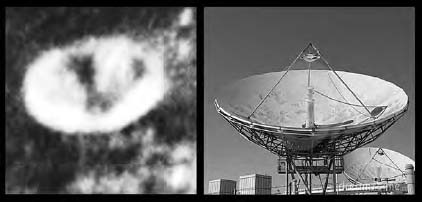Ancient Aliens on the Moon (17 page)
Read Ancient Aliens on the Moon Online
Authors: Mike Bara

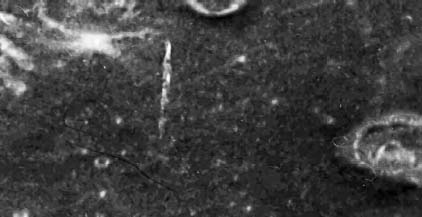
Pie-shaped partial dome over the crater Picard from AS16-121-19438.
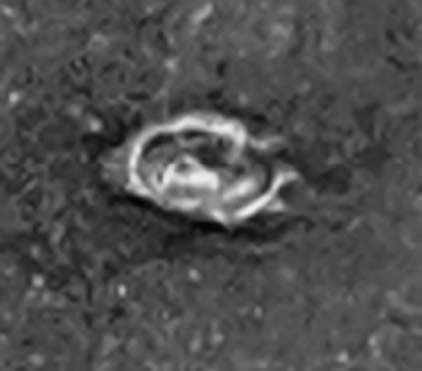
High contrast version of crater Picard from AS16-121-19438.
While the standing, pie-shaped section is not visible in this image, close up enhancement of the area around the crater itself reveals what appear to be dark, structural arches rising over the crater rim. They would certainly account for the dark, striped markings seen on the rim of the crater from the orbital photo AS16-121-19438.

close-up of Picard from AS16-121-19438 showing glass-like reflections and odd striations on northern lip.
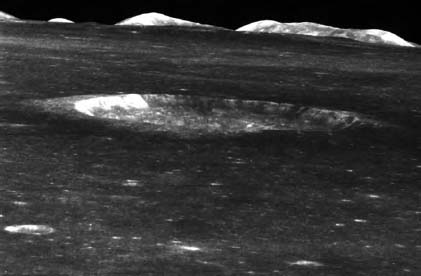
Picard crater from Apollo frame AS10-30-4421. Note the hazy appearance and the dark arches on the farside crater rim.
So how to explain these discrepancies? For one, it is not necessarily expected that we’d be able to clearly see a partially intact watch crystal type dome over a crater from every angle. Remember, these objects and the scaffolding are transparent, and they will reflect light only under ideal circumstances and when the camera is pointed at the reflection at just the right angle. Also, a glass structure such as this would need reinforcement, rebar if you will, to hold up the sections of pie shaped wedges to make such a dome. If these had collapsed, we’d expect them to fold over, in which case they’d tend to form arches just like the ones barely visible in AS10-30-4421. If only we could get a sharp, unobscured view of the crater, we might be able to see enough to resolve the question of whether Picard once had a glass dome over it. But neither of the two images seem to be all that clear. The reason for this and the gauzy haze that astronaut Worden talked about is obvious; there is some type of nearly transparent medium between the camera and the crater in both images. And that medium is our immense scaffolding type crystal towers.
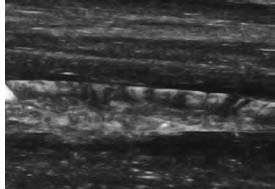
Close-up of dark arches over northern lip of Picard crater from AS10-30-4421.

AS16-121-19438.
Let’s take another look at NASA frame AS16-121-19438.
Besides the presence of the Spire, there are several other things “wrong” with this picture. At the bottom of the frame, you’ll notice two oddly lighter hexagonal shaped areas of the photo over the lower part of Crisium. These are actually lens flares from the hand held 70mm Hasselblad cameras that the astronauts used and are fairly common on all the hand held photography. But once you get past that, there is still something not quite right about the lower half of this photograph which is not related to the Hasselblad lens flares.
If you look in the lower left hand corner, you can see a distinct darkening, as if something were obscuring the craters and features below. This odd darkening spreads all across the lower portion of the photo and can only be accounted for by the presence of a semi-transparent intervening medium—like glass—being between the camera and the lunar surface below. This intervening medium— our crystal towers, are bending and obscuring the light just like an atmosphere would under the same circumstances. The result is a kind of “Levolor blinds” effect that is reducing the amount of light in the lower part of the image. Given the altitude of the spacecraft, these “blinds” must be truly immense, just as the images we’ve seen so far imply.

Enhanced version of AS16-121-19438. Note odd darkening in lower portion of image.
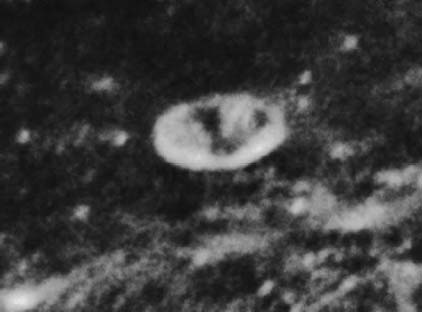
Satellite dish like crater Asada in the Mare Crisium region. Note the supporting structure under the “dish.”
And there are other bizarre anomalies all over this image. As we look northward to the highlands, some of the most distinctive features, like the craters Asada and Proclus, actually look more like satellite dishes than craters.
Now, this could all be chalked up to an optical illusion, but upon further enhancement you can plainly see an engineering structure under the “crater” holding Asada up. It has vertical struts and horizontal members which appear to be the underlying support for the dish.
Notice also that there are regularly spaced dark areas under the dish where there are gaps in the girders holding the dish up. The dark shadow in the center of the dish is probably cast by the central mast of the dish subreflector. Unfortunately this cannot be made out at the resolution of the photograph. The point is, all radio telescopes and satellite dishes have the same basic components; a parabolic reflector dish, a subreflector mounted on a mast over the dish, and an underlying subsctructure of griders and supports that not only hold up the dish, they also house the mechanism that rotates and aims the dish in a specific direction. Asada seems to have all of these distictive features.
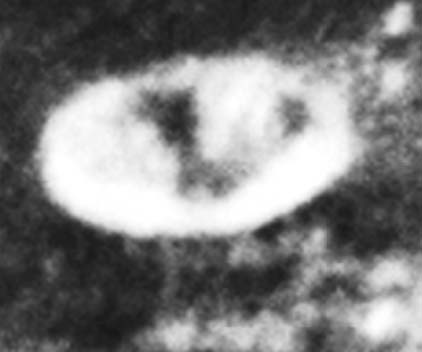
Contrast enhanced version.
